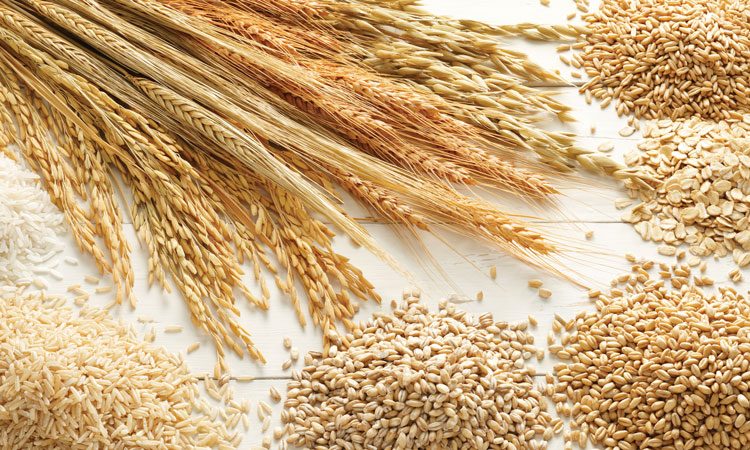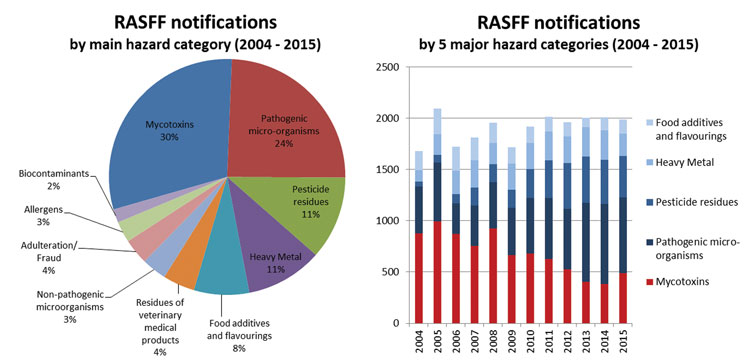MyToolBox – the smart way to tackle mycotoxins
- Like
- Digg
- Del
- Tumblr
- VKontakte
- Buffer
- Love This
- Odnoklassniki
- Meneame
- Blogger
- Amazon
- Yahoo Mail
- Gmail
- AOL
- Newsvine
- HackerNews
- Evernote
- MySpace
- Mail.ru
- Viadeo
- Line
- Comments
- Yummly
- SMS
- Viber
- Telegram
- Subscribe
- Skype
- Facebook Messenger
- Kakao
- LiveJournal
- Yammer
- Edgar
- Fintel
- Mix
- Instapaper
- Copy Link
Posted: 5 April 2017 | Birgit Poschmaier - PhD student at BOKU, Monique de Nijs - RIKILT, Rudolf Krska - BOKU | No comments yet
There is a pressing need to mobilise and integrate the wealth of knowledge from the international mycotoxin research conducted over the past 25-30 years, in order to perform cutting-edge research to close knowledge gaps. This is the mission of MyToolBox – a four-year project, funded by the European Commission from 2016 to 2020.


It facilitates a multi-actor partnership to develop novel intervention strategies aimed at achieving up to 90% reduction in crop losses due to mycotoxin contamination for major food and feed crops. Besides a field-to-fork approach, MyToolBox also considers safe use options of contaminated batches, such as the efficient production of biofuels. The distinguishing feature of MyToolBox is to provide the recommended measures to the end users along the food and feed chain in a web-based MyToolBox platform (e toolbox), focusing on small grain cereals, maize, peanuts and dried figs, applicable to agricultural conditions in the EU and China.
Introduction – the mycotoxin problem
The mycotoxin contamination of crops is a major concern for stakeholders along the food and feed chain. The European Commission pointed out that 5–10% of global crop production is lost annually due to mycotoxin contamination.1 The total costs of losses due to mycotoxin contamination, such as reduced yields; food and feed losses; increased costs for inspection and analyses; as well as others, may easily reach billions of Euros annually, as estimated by Mitchell and colleagues.2 Mycotoxin-contaminated cereals and derived products, such as dried distillers´ grain solubles (DDGS) in animal feed, impact livestock production as well. For example, the decreased weight gain in pigs in the USA, due to including 20% DDGS contaminated with fumonisins in the feed, is estimated to result in losses of up to US$147 million annually.3


Figure 1: RASFF notifications from 2004 – 2015 (left) and RASFF notifications of five main hazards from 2004 – 2015 (right)
The social impact of mycotoxin contamination is also of growing concern since recent reports suggest possible links between aflatoxin exposure and the stunting of children in Africa.4,5 Furthermore, extreme weather events due to climate change impact the mycotoxin map world-wide,6 thus challenging existing forecasting and detection methods of mycotoxins in food and feed. Despite previous achievements, the risk of mycotoxin exposure is still high: 81% of globally collected feed samples were contaminated with at least one mycotoxin and 45% contained more than one secondary metabolite of fungi.7 Furthermore, most notifications registered in the EU’s Rapid Alert System for Food and Feed (RASFF) between 2004 and 2015 were related to mycotoxin contamination exceeding the maximum regulatory limits8 (see Figure 1). Thus, despite previous achievements in tackling mycotoxin exposure from food and feed, continuous and collaborative research is needed.
MyToolBox – the smart way to tackle mycotoxins
To tackle these issues, existing knowledge must be combined with novel findings to bridge gaps on mycotoxin reduction along the food and feed chain. By using mainstream information and communication technology (ICT), losses and waste along the food and feed chain can be prevented and traceable information to the supply chain and consumers can be provided. This is the mission of MyToolBox (see Figure 2), a four year project, which is funded by the European Commission (EC) and was launched in March 2016. The project applies a multi-actor and multi-disciplinary approach throughout the food and feed chain with 40% industry participation including five end users and three well-known institutions from China, who will collaborate closely with farmers and stakeholders from the industry. The end-user engagement, which extends to the food and feed industry, farming communities, agronomists, manufacturers, SMEs and academia from the EU and beyond, will ensure the usability and applicability of the MyToolBox decision support system.


Figure 2: Overview of the MyToolBox project approach (©IRIS)
The overall objective of the MyToolBox project is to develop a series of integrated measures that reduce different kinds of losses that result from mycotoxin contamination. MyToolBox specifically addresses the most prevalent Fusarium mycotoxins (Deoxynivalenol [DON], T-2 toxin, HT-2 toxin, Zearalenon [ZEA] and fumonisins) in wheat, oats, maize and animal feed, ochratoxin A (OTA) in wheat and aflatoxins in maize, peanuts and dried figs. Besides a field-to-fork approach, MyToolBox also considers safe use options of mycotoxin-contaminated batches to efficiently produce biogas and bioethanol, thus considering alternative use options of otherwise wasted cereal badges. Legislative implications are also foreseen, for which advice is sought from institutions experienced in establishing regulatory limits for contaminants in foods and feeds, such as from representatives from the European Food Safety Authority (EFSA) and the EC’s Directorate-General DG Santé. Eventually, a sound scientific basis for setting authorisation standards of mycotoxin detoxifying feed additives in China will complement the project’s goals.
Expected impacts along the food and feed chain
The pre- and post-harvest measures should lead to significant economic and food safety benefits and improvements in mycotoxin management along the food and feed chains, leading to a reduction of contamination incidents and more transparent communication in the supply chains. Furthermore, farmers and other stakeholders along the food and feed chain will benefit financially by saving resources (e.g. fertilisers, seeds, etc.) and by lowering the risk of rejection of their products due to unexpected contamination. As such, mycotoxin-related border rejections noted by RASFF are expected to decrease further. Overall, the integrated measures are expected to lead to a 20-90% reduction of mycotoxin contamination in food and feed, thus contributing to improved consumer trust in imported food and feed.
The pre-harvest measure focus on in-field strategies – to determine the most promising available novel cultural biocontrol strategies targeting the Fusarium inoculum within crop debris, Brassica biofumigation,9,10 as well as accelerated biodegradation11 with an extract or competitive fungi12 – are being explored. To increase the climate change resilience of EU-maize farmers and thus reduce susceptibility of maize to aflatoxin contamination, MyToolBox is testing two measures: (1) The selection of appropriate genotypes of maize with various traits, and (2) The application of atoxigenic Aspergillus strains to out-compete toxigenic Aspergillus strains in the field. In addition available forecasting models regarding DON contamination in wheat and maize are being validated, combined and extended to cover the most important wheat and maize growing areas in Europe.
Post-harvest strategies span from the sorting of crops, over storage and further processing; up to alternative uses of contaminated batches. In order to achieve significant improvements in the sorting of dried figs (and dramatically improve the work environment) MyToolBox is developing a non-invasive system for the real-time sorting of contaminated dried figs, based on visible and near infrared (NIR) spectral imaging and appropriate algorithms. Innovative pre-milling and milling strategies are combined and up-scaled to provide more accurate separation of grain tissues that have characterised (different) mycotoxin contamination levels. Milling strategies, such as debranning and micronisation, are efficient, but individual tissues of the grains are often inhomogeneous and not well confined. The synergistic potential of debranning, micronisation and dry- or wet-turbo separation will minimise the mycotoxin concentration in raw materials and the final wheat products destined for the consumer. Within MyToolBox the fate of mycotoxins, as well as their modified forms and co-occurrences in naturally contaminated raw materials (with simultaneous co-occurrence of different mycotoxins), will be monitored during thermal food processing at an industrial scale with Barilla (Parma, Italy), one of the industrial partners. These efforts fulfill the need to obtain further data on the fate of modified mycotoxins, as defined by EFSA in 2014,13 during food and feed processing.
The outcome of the MyToolBox studies shall also positively contribute to the current food vs. fuel debate, due to our intention to utilise mycotoxin contaminated batches to produce biofuels on the one hand, and high quality DDGS on the other. In DDGS, a major protein source in feeding stuffs derived from bioethanol production, the mycotoxin concentration can be increased by a factor of three compared to the starting maize.14 To reduce the mycotoxin contamination of DDGS, the MyToolBox industry partners Südzucker (Mannheim, Germany) and BIOMIN (Getzersdorf, Austria), in cooperation with BOKU/IFA-Tulln, will study the effects of specific mycotoxin-degrading microorganism strains15 and novel enzymes16 on the reduction of DON and fumonisins in DDGS.
The EU-China partnership within MyToolBox aims to contribute to the standard setting for authorisation of mycotoxin-detoxifying feed additives in China, wherein current EU guidelines for the registration shall serve as examples for possible adaptions of Chinese legislation. This shall include standardised procedures to verify the safety and in vivo efficacy of detoxifying feed additives. Currently in China, up to 24% of complete feed for pigs have exceeded the maximum limits of deoxynivalenol set by the Chinese authorities.17 Since approximately half of the world´s total pig population is farmed in China, such legislation is expected to also improve the efficiency of Chinese pork-meat production.
Finally, the web-based MyToolBox platform will represent a one-stop-shop for farmers and other decision makers in the food and feed supply chain. Consisting of information and advisory modules, as well as management tools and technologies, such individuals will be equipped with systematic, cost effective and affordable approaches for the effective monitoring and reduction of mycotoxin contamination in crops, food and feed.
This will lead to the increased trust of consumers in the high quality of EU food and feed, which will strengthen the economic position of the EU food producers.
Conclusion
The MyToolBox project does not only pursue a field-to-fork approach to reduce mycotoxins in wheat, oats, maize, peanuts and dried figs, but also considers safe use options of mycotoxin contaminated batches. This will increase the availability of high quality food and feed in the EU as well as in China. Various agricultural strategies used thus far have not been able to efficiently reduce the impact of fungal infection, let alone take account of climate change related issues or other analytical challenges. The current situation pursues a novel and integrated multi-actor approach involving all actors in the food and feed chain, including the end-users. Consequently, the MyToolBox approach combines a series of integrated pre- and post-harvest measures, which could enable a 20-90% reduction in loss of crops due to fungal and mycotoxin contamination, depending on the type of commodity and intervention.
Acknowledgements
The authors are grateful to all partners’ contributions, in particular Simon Edwards from Harper Adams University, Michele Suman from Barilla, Naresh Magan and Angel Medina Vaya from Cranfield University, Ine van der Fels-Klerx from RIKILT Wageningen University & Research, Vittorio Rossi from HORTA S.R.L., John Gilbert from FoodLife International, Edurne Gaston Estanga from IRIS and Michaela Pichler from ICC.
This project has received funding from the European Union’s Horizon 2020 research and innovation programme under grant agreement No 678012.
About the authors






References
- European Commission (EC) (2015). European Commission Decision C (2015) 2453: Horizon 2020 Work Programme 2014 – 2015: Food Security, sustainable agriculture and forestry, marine and maritime and inland water research and bioeconomy (revised). Available at: https://ec.europa.eu/research/participants/data/ref/h2020/wp/2014_2015/main/h2020-wp1415-food_en.pdf (Accessed August 2016)
- Mitchell N, Bowers E, Hurburgh C, Wu F (2016). Potential economic losses to the US corn industry from aflatoxin contamination. Food Additives and Contaminants: Part A 33(3):540-550
- Wu F, Munkvold GP (2008). Mycotoxins in ethanol co-products: modeling economic impacts on the livestock industry and management strategies. Journal of Agricultural and Food Chemistry 56: 3900-3911
- Matacic C (2016). Fungal toxins are poisoning Africa’s children, says new report. Available at: http://www.sciencemag.org/news/2016/02/fungal-toxins-are-poisoning-africa-s-children-says-new-report. (Accessed August 2016)
- Wild CP, Miller JD, Groopman JD (2015). Mycotoxin control in low- and middle-income countries. International Agency for Research on Cancer (IARC) Working Group Report No. 9, the World Health Organization, Lyon, France
- Battilani P, Toscano P, Van der Fels-Klerx HJ, Moretti A, Camardo Leggieri M, Brera C, et al. (2016). Aflatoxin B1 contamination in maize in Europe increases due to climate change. Scientific Reports 6:24328. DOI: 10.1038/srep24328
- Nährer K, Kovalsky P (2014). The Biomin mycotoxin survey: Identifying the threats in 2013. Science and Solutions, April 2014. ISSN: 2309-5954. Available at: http://www.biomin.net/uploads/tx_news/MAG_SciSol_Special_MTX_EN_0414.pdf
- European Union (2016): RASFF Portal, https://webgate.ec.europa.eu/rasff-window/portal/?event=searchForm# (Accessed November 2016)
- Ngala BM, Haydock PP, Woods S, Back MA (2015). Biofumigation with Brassica juncea, Raphanus sativus and Eruca sativa for the management of field populations of the potato cyst nematode Globodera pallida. Pest Management Science 71: 759-769
- Perniola OS, Staltari S, Chorzempa SE, Astiz-Gassó MM, Del Carmen Molina M (2014). Biological control of Fusarium graminearum: use of Trichoderma and biofumigation with aerial part of Brassica juncea. Revista De La Facultad De Ciencias Agrarias 46: 45-56
- Hofgaard IS (2012). Reduction in the inoculum potential of F. graminearum on residues after treatment with Biowish crop or Trifender after sowing in spring (unpublished internal report)
- Matarese F, Sarrocco S, Gruber S, Seidl-Seiboth V, Vannacci G (2012). Biocontrol of Fusarium head blight: interactions between Trichoderma and mycotoxigenic Fusarium. Microbiology 158: 98-106
- EFSA CONTAM Panel (2014). Opinion of the Scientific Panel on Contaminants in the Food Chain on a request from the Commission related to the presence of modified forms of certain mycotoxins in food and feed. EFSA Journal, 12: 3916- 4023
- Schaafsma AW, Limay-Rios V, Paul DE, Miller JD (2009). Mycotoxins in fuel ethanol co-products derived from maize: A mass balance for deoxynivalenol. Journal of the Science of Food and Agriculture 89: 157-1580
- Commission Implementing Regulation (EU) No 1016/2013 of 23 October 2013 concerning the authorisation of a preparation of a micro-organism strain DSM 11798 of the Coriobacteriaceae family as a feed additive for pigs [2013] OJ L282/36
- Commission Implementing Regulation (EU) No 1115/2014 of 21 October 2014 concerning the authorisation of a preparation of fumonisin esterase produced by Komagataella pastoris (DSM 26643) as a feed additive for pigs [2014] OJ L302/51
- Li XY, Zhao L, Fan Y, Jia Y, Sun L, Ma S, Ji C, Ma Q, Zhang J (2014). Occurrence of mycotoxins in feed ingredients and complete feeds obtained from the Beijing region of China. Journal of Animal Science and Biotechnology 5: 37-44
Issue
Related topics
Contaminants, Food Safety, Lab techniques, Mycotoxins, Research & development, Supply chain
Related organisations
Barilla Spa, Biomin, European Commission, European Food Safety Authority (EFSA), Südzucker









